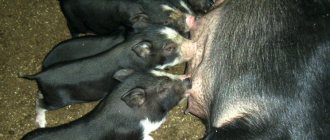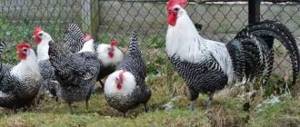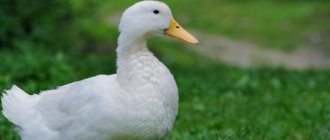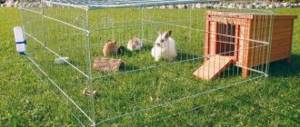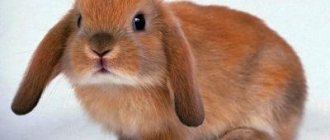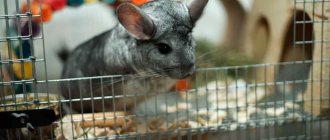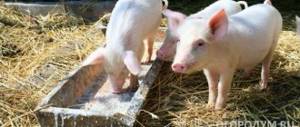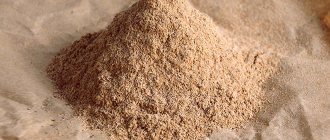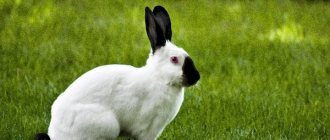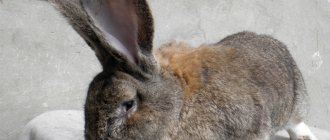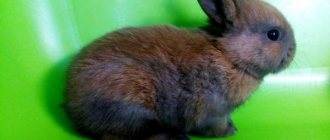History of the breed
The author of the breed is considered to be the Austrian breeder Johann Konstantin Schulz. It took the scientist two years to obtain a new variety, during which he crossed several individuals of Flanders and Moravian rabbits and selected new specimens.
In 1897, a beautiful rabbit called the Vienna Blue Giant appeared at the Vienna Prater Animal Exhibition. This specimen actually weighed more than seven kilograms.
But further research showed that for the purpose of farm breeding, fattening an animal to such a weight is unprofitable. Therefore, the breed was adjusted and received the final name Vienna Blue. In addition to tasty meat, it is famous for its high-quality fur, high fertility of females, and unpretentiousness. Then the breed began its victorious march across Europe, and in the 30s of the last century it appeared in Russia.
Soviet rabbit breeders were interested in the breed, and it was acclimatized to the conditions of our country. At the same time, the weight of the individuals increased slightly, and the quality and size of the skin also increased.
Photo gallery of the Viennese Blue breed:
Origin of the Viennese Blue rabbit breed
As you might guess from the name, this breed comes from the outskirts of the Austrian capital, Vienna. At the end of the 19th century, the head of the Vienna Union of Rabbit Breeders, Johann Schulz, set out to create a new meat breed that would be distinguished not only by good meatiness, but also by beautiful, high-quality fur.
Through the efforts of Schultz and his like-minded people, the breed was created and in 1895 it was presented to the public. The basis for the new variety of meat rabbits was taken from the already quite popular at that time Belgian giant rabbits of the Flanders breed, which were crossed with a local small breed called Moravian rabbits. During the breeding process, Schultz and his team selected for crossing only those animals that had a blue-gray coat color. Ultimately, it was the color and location of the breed that gave it its name.
Already in the first years of the 20th century, Vienna Blue rabbits became the object of breeding by farmers in Switzerland, Holland and Germany. With each decade, the popularity of the breed grew and today in Germany, for example, the Vienna Blue rabbit is one of the most popular breeds. It is also popular in other countries, although it is not the undisputed leader, as in Germany.
Viennese rabbits first came to our country in the late 1920s, when the first serious attempts to put rabbit breeding on an industrial footing were made in the USSR. Then, along with Austrian rabbits, representatives of several other “top” European breeds of that time were imported. However, at that time Viennese rabbits did not gain much popularity among us, and rabbit breeding in general did not receive the development that was originally expected.
The second and this time more successful attempt at breeding Viennese blue rabbits in Russia took place in the 1960s, when rabbit breeding finally began to actively develop in our country. From the very beginning, the task was set not only to acclimatize, but also to improve this breed, adapting it as much as possible to domestic climatic and economic realities. Soviet breeders put a lot of effort into improving the basic characteristics of the Viennese blue rabbit - increasing the average live weight and size of the animal's skin, as well as improving the quality of the fur. At the same time, work was carried out to adapt Viennese rabbits to the weather and climatic conditions and food supply of the central and northern regions of the USSR.
Over time, the breed has gained quite a lot of popularity not only among industrial rabbit breeders, but also among private amateurs. The reason for this was both the good meat characteristics and the excellent quality of the skin of these animals.
Mr. Tail recommends: description and standard
There are several standards for the Vienna Blue breed in the world, but there is no single international standard. Here are the characteristics and description of the Russian version:
- Head. Massive, with a wide forehead and large cheeks.
- Eyes. Large, slightly convex, widely spaced. Color - black or brown. Albinos have only bright blue ones.
- Ears. Standing, quite long (13-16 cm).
- Neck. Short, almost invisible.
- Body. Medium size (57-58 cm), chest girth 37-38 cm. Congestion index (body density) 60-64%, which determines the mesosomal type of build.
- Paws. Straight, strong and strong. The front ones are much shorter than the rear ones.
- Fur. Short, dense, shiny, evenly colored, the undercoat is slightly lighter than the main hair.
- Color. Dense blue, sometimes bluish with a metallic tint.
- Weight. The body weight of an animal ready for slaughter is 3.5-5.4 kg.
- Fertility. Average. The number of rabbits in a litter is from 6 to 9.
- Precocity. High. By the age of 3 months, the rabbit’s weight reaches 3.5 kg.
- Good yield. Average - 58-59%.
For other countries, weight indicators are slightly different. France 3.6-4.5 kg; Germany - 3-4 kg, Denmark - 4.6 kg. For the albino species they are different. France - 2.7-3.6 kg, Germany - 3-4 kg, Denmark - 3.8 kg.
The tightness index is determined by finding the percentage ratio of chest circumference to body length. According to this parameter, the types of rabbits are divided:
- mesosomal (medium elongated) - 60-64%;
- leptosomal (long-extended) - up to 60%;
- erysomal (short-bodied) - more than 64%.
Based on this index, we can talk about the quality of the skin. The Vienna Blue's fur quality is considered slightly above average.
It is also assessed by the thickness of its fur. To do this, determine how many hairs are located on one square centimeter of skin.
For comparison, the following data is provided:
- Vienna blue - 21 cm²;
- Black and white - 24 cm²;
- Soviet chinchilla - 23 cm²;
- White giant - 19.2 cm²;
- Giant gray -16 cm²;
- Angora - 12-13 cm²;
- Rex, German ram - 24-25 cm².
That is, in terms of the quality of fur, the Viennese rabbit is only slightly inferior to the Rex rabbits with their velor velvet dense fur.
For successful breeding of meat and skin breeds, the character of the animals is also important. Thus, very calm, even phlegmatic varieties are considered the best; they are less susceptible to stress.
The Vienna Blue is quite complex in this regard, as it is overly impulsive and sometimes aggressive when mated. Therefore, novice rabbit breeders are not recommended to start with this breed.
Breeding and raising rabbits
Despite the fact that Viennese blue rabbits are unpretentious and quite simple to care for and maintain, if you want to obtain and raise young animals, you need to approach this issue in more detail.
Principles of selection for reproduction
Not all individuals in a herd have the same fertility, so it is very important to be able to correctly classify animals - to divide them into commercial ones, which will be fattened for subsequent slaughter, and repair ones, intended for use in breeding.
Professional rabbit breeders, when selecting replacement young animals, stretch this process into 3 stages, and each time only the best ones are retained from the previously selected individuals.
The sampling frequency is usually as follows:
- The first, preliminary stage coincides with the moment the cubs leave the mother rabbit. This moment, depending on the technology used, can take place from the 28th to the 60th day from the moment of birth of the rabbits.
- The next, more careful selection takes place when the animals have reached 3 months,
- The final formation of the future parent herd occurs at 4–4.5 months, when the rabbits have reached sexual maturity.
Important! When forming a parent herd, it is very important to prevent close relatives from mating, which leads to the appearance of weak offspring. Therefore, animals of the same line must be marked accordingly or kept separately from each other.
Main selection criteria:
- absence of congenital defects;
- the most harmonious physique;
- healthy appearance;
- rapid development corresponding to the breed standard (all weak and sickly individuals are discarded);
- good development of the mammary glands in females (this factor can only be assessed at the last stage of selection and is the most important for female rabbits, since it is this factor that guarantees the ability of an individual to bear and feed cubs).
Fostering and caring for young animals
Although rabbits reach sexual maturity at 4.5 months, experienced rabbit breeders categorically do not recommend mating for the first time at this age. It is believed that mating of animals can begin no earlier than 7 months, and some experts recommend postponing this process for another 3-4 months.
With a good litter after the first mating, a successful pair is preserved for 5 years. If the average number of rabbits does not reach the desired levels, the parents are slaughtered after 3–4 years, replacing them with replacement young animals. However, it is necessary to keep in mind that the multiple births of a pregnancy largely depend on the male, so in a couple you can try to replace only him. However, if the female does not feed the offspring, much less is noticed eating them (this also happens), then she is slaughtered immediately, even if the pregnancy was successful and turned out to be multiple.
Did you know? For some reason, births in female rabbits most often occur at night or immediately after dawn.
Rabbits are very fertile animals. Pregnancy in a female lasts only 28–35 days, and the feeding period, taking into account the time of gradual transition to “adult” food, is no more than 8 weeks. Nevertheless, in order to maintain the health of the female rabbit and prevent the appearance of weakened offspring, the number of productive matings during the year should not be more than 5. And of course, during pregnancy, the female should receive enhanced nutrition and be protected from stress in every possible way.
For the first month after birth, the rabbits remain with their mother, remaining under her emotional protection and receiving constant access to mother's milk. The cubs can then be placed in a separate cage, although, as already mentioned, some farmers extend the cohabitation of the young with their mother to 60 days.
Feeding baby rabbits
The diet of baby rabbits from the moment of birth to the 28th day of life is exclusively mother's milk, which contains everything that growing babies need.
Did you know? The fat content of rabbit milk is 15%. For comparison, the maximum fat content of goat milk is 6%, while in cow milk this figure averages 3.2–5.5%.
Then the rabbits gradually begin to be given hay and dry food, and after 60 days, when mother’s milk is no longer in the baby’s diet, greens and other products of the adult diet, except vegetables and fruits. This part of the feed, as the most dangerous and difficult for the rabbit’s sensitive digestive system to digest, is allowed to be tried by young animals no earlier than 4 months of age. It is very important to give each new type of complementary food a little, carefully monitoring the baby rabbit’s reaction.
Newborn babies usually eat no more than 3 times a day, therefore, unlike most other domestic animals, there is no need to accustom growing babies to less frequent meals - their diet remains unchanged throughout their lives. However, you need to keep in mind that during the breaks between main feedings, an adult animal from time to time feasts on hay or gnaws on hard objects (tree branches, bark, etc.), and the number of such “snacks” can reach up to 70 per day.
Varieties
Initially, only one color of the Viennese rabbit was recognized, namely blue. But over time, rabbit breeders began to believe that other colors had a right to exist.
Viennese albino
No different from the Viennese standard color, only with a snow-white coat and eyes of an amazing cornflower blue color. This albino never has red eyes.
The variety was obtained by the famous breeder Wilhelm Muk by hybridizing two breeds - the standard Viennese blue and the Dutch blue-eyed.
These animals are so beautiful that recently they are increasingly kept at home as decorative pets.
Black Vienna
This variety has an amazingly beautiful coat - anthracite-glossy, thick. And the weight of adults is even slightly higher than that of a standard blue rabbit. Obtained by crossing the original color with the Alaska rabbit.
Features of reproduction
The female bears the offspring for one month. In one litter, up to 10 newborn babies are born. Already at 4 months they gain more than 65% of the body weight of adults. The female rabbit has a well-developed maternal instinct. Newborn babies are able to survive even in harsh winter conditions. The milk productivity of females is high.
In some cases, with uncontrolled matings, the following signs appear:
- the fur is short and dull;
- the color of the coat changes and is heterogeneous;
- the shapes are disproportionate;
- maximum body weight is 4 kilograms.
Care and maintenance
Viennese blue rabbits do not have any difficulties in daily care and maintenance. The main requirements must be met:
- Prevent drafts. To do this, cages, enclosures, and sheds should be positioned correctly.
- Protect from direct sunlight. This is also influenced by the location of the rabbits’ dwellings and their equipment with reliable canopies.
- Maintain a high sanitary and hygienic level, which should be facilitated by a cage design that makes them easy to clean. It is also important to regularly change the hay mats.
- Monitor the health of pets and prevent outbreaks of infections. To do this, the cages must be clearly visible so that the farmer can see all the animals.
- Feed nutritiously, which will help prevent diseases in the livestock and give individuals the opportunity to quickly gain weight.
Also, when keeping Viennese blue rabbits, it is important to remember that these animals are very energetic, so drinkers and feeders in cages should be arranged in such a way that they cannot be overturned and broken. The best option would be nipple, vacuum, and bunker systems.
If rabbits are outdoors, then for the winter period it is necessary to provide either insulation of the cages or their reconstruction indoors.
In addition, these rabbits are so temperamental and touchy that they can bite a person if they don’t like something. Therefore, it is important when keeping this breed to never raise your voice near enclosures, to behave calmly and friendly with your pets, and not to frighten them.
You should not keep Viennese Blues in pits. The skin of this breed is no less valuable than the meat, and in such conditions it will suffer and the quality of the fur will decline.
Of all the housing methods, the most optimal is the shad one, when all animals are under a common canopy and are well protected from bad weather, heat and drafts.
Animal care
The description of the advantages of Vienna rabbits, which was given above, is a good reason to believe that breeding them is quite a profitable business. However, the success of the enterprise, of course, directly depends on the conditions in which the animals are kept, on vaccination and on a proper and varied diet. When you buy rabbits, make sure that the animals are vaccinated and set a schedule for further vaccinations.
Experienced livestock breeders say that the Viennese blue rabbit is unpretentious to the conditions; it lives well both in rabbitries, equipped with the latest technology, and under a canopy in cages or in outbuildings. It is recommended to keep rabbits separate from female rabbits and allow each other only during the mating period.
See also: Varieties of meat rabbits
Animals eat more than 30 times a day and also drink a lot, so the breeder must ensure that they have enough food and water. To prevent bacteria from multiplying in animals’ homes, manure must be removed regularly.
If you want to take a rabbit home, you can do it completely calmly - they do not bite, unlike other breeds, they behave calmly and are very friendly. But remember that just like their brothers, they gnaw everything that comes their way, therefore, after releasing a rabbit at home, you need to monitor the animal all the time.
If you take good care of your rabbits, they will live with you for up to 7 years; some individuals that are in better health can live up to 12 years.
Feeding
Vienna Blues, like all breeds, are herbivores. They constantly chew grass and hay.
If rabbits begin to eat feces, then the farmer is faced with the phenomenon of caecotophoria. There is nothing wrong with this, this is an evolutionary adaptation mechanism that arose in the wild to replenish certain minerals in the bodies of animals and corresponds to the repeated digestion of grass in ruminant species.
In order to increase the yield and quickly fatten Viennese rabbits, it is necessary to correctly prepare their diet. It should contain the following types of feed:
- rude;
- juicy;
- green;
- concentrated;
- vitamin supplements and minerals.
The best choice of herbs would be to include lupine, oats, winter rye, clover, vetch, alfalfa, corn, peas and others.
Coarse ones must contain straw from grain crops, meadow and steppe herbs in the form of hay, branches and bark of maple, acacia, linden, willow, willow, and coniferous trees.
In small quantities, juicy additives are introduced into the diet in the form of chopped fruits (apples) and vegetables (zucchini, pumpkin, carrots, cabbage), and silage.
In winter, feed, bran, cake, fish and meat and bone meal, acorns, whey, and milk are added.
Breed productivity
The Vienna Blue breed is one of the most profitable fur-skin species. Almost all parts of the skin are suitable for making both clothing items and interior and design elements. The beautiful bluish tint and softness make it possible to use the fur of blue rabbits to imitate products from more expensive varieties of fur-bearing animals. In terms of cost, the skins of this breed are second only to ermine. However, they provide little meat. The weight of a live rabbit rarely exceeds 5 kg, and the finished product is only about 2 kg. And in terms of taste, the meat cannot be called a delicacy; it is tough and stringy (Viennese blues have little fat). This article will tell you how to care for a decorative rabbit.
Due to such a narrow specialization, it is profitable to keep these rabbits only in large production facilities focused on the production of fur and fur products. Many people will also keep them as decorative pets.
Breeding
There is nothing difficult about breeding Viennese blue rabbits. Individuals mature early, at 5-8 months, with females earlier than males.
For a female rabbit during pregnancy, it is necessary to organize mating on the male’s territory and repeat it after 5-7 days.
The only thing is that you should be very attentive to the behavior of animals at this moment. Sometimes rabbits behave so impulsively that they can severely bite a rabbit and even a person if they try to protect her.
The gestation period is short - from 28 to 32 days. The female must be immediately placed in a cage with a queen cell. She will begin to prepare the nest - dragging straw and hay there, mixing them with the fluff plucked from the chest.
Viennese rabbits often give birth early in the morning and quickly - within 10-50 minutes. Human assistance is usually not required.
Female Viennese blue rabbits have proven themselves to be excellent and caring mothers. They always have a lot of milk, they never eat children, and they carefully look after them. At the same time, they instantly recover after childbirth and within a day they are ready for a new mating.
Winter cubs have a high survival rate even in unfavorable weather conditions and severe frosts.
Newborn Vienna rabbits weigh 65-70 g, and by 2 months they already exceed 1.5 kg. At 28-30 days, the cubs begin to be vaccinated, having previously undergone deworming.
Young animals intended for fattening are removed from their mother at 2 months and separated by gender to prevent spontaneous mating.
It is believed that the most cost-effective would be to slaughter by 5 months, and the best quality of skins is in the autumn and winter.
Based on the combination of a number of characteristics (precocity, fertility, quality of meat and skins, unpretentiousness), this breed is considered one of the best for private and industrial farming.
Keeping and caring for the Viennese blue rabbit
Rabbits of this species are generally not picky in matters of keeping, and since they are characterized by good endurance, they can be kept both in a cage and in the open air.
When caring for rabbits, you must follow fairly simple but important rules. For example, if you decide to keep your rabbit indoors, then you just need to purchase a cage that will be comfortable for your animal.
Do not forget about the usual rules of hygiene, keep the animal’s cage clean. This method of keeping has a number of advantages, for example: you yourself regulate the mating of rabbits, reduce the risk of the spread of various infectious diseases among rabbits, each representative of this breed will be provided with an individual diet.
Due to the fact that rabbits are not particularly picky, they can also be kept in places such as barns, various rabbit hutches and sheds. Some particularly sophisticated and caring owners prefer to combine these living conditions for animals.
By nature, this breed is very kind and calm, so representatives of this species are simply taken as pets. But they are often bred for their tasty meat and beautiful fur.
Health and prevention
Viennese blue rabbits are distinguished by high immunity and good health. But to prevent the loss of livestock, it is necessary to strictly adhere to the deworming schedules and vaccination schedules against myxomatosis, VHD, and rabies.
A number of possible diseases affecting the gastrointestinal tract will be helped by maintaining a high sanitary and hygienic level of keeping rabbits and regular cleaning and disinfection of cages.
The only thing you have to fight is pododermatitis, the formation of peculiar corns and ulcers on the paws. This pathology occurs, as in all heavy breeds, from the animal sitting for a long time on a slatted or hard floor. Frequently replacing the hay can help here.
Health
Calluses (pododermatitis) can be a big problem. Vienna is a heavy breed and mesh floors are not very suitable for large animals. It is better to keep breeding animals on a plank floor, which prevents injuries to the hock joint. The incidence of infections, worms, parasites (coccidiosis) in Viennese rabbits is the same as in animals of other breeds.
Acquisition
For fattening, young animals are purchased starting from one month of animal life, and for breeding - at 3-4 months.
Most often, the acquisition of a couple for a tribe is accompanied by the receipt of the following documents:
- Veterinary certificate on the health status of animals (F1).
- Veterinary certificate (F4).
- Registration certificate for breeding animal.
- Veterinary passport.
These documents are issued only to those individuals who have been fully vaccinated against myxomatosis, rabies, and VGCH.
Before buying Viennese blue rabbits, you need to make sure that they are healthy, that is, they have shiny fur, clean eyes, nose and genitals.
For purebred animals purchased for breeding, the bite, color and condition of the eyes, ear size, paw length, and compliance of other breed qualities with the standard are also checked.
The cost of these rabbits is quite high. Juveniles for fattening are sold for 700-800 rubles per kilogram of live weight, and breeding individuals can cost from 3500-5000 (rabbits) to 5000-8000 (female rabbits).
Content Features
Rabbits of this breed are unpretentious to growing conditions. A traditional rabbitry can be equipped for them. Also, cage rooms can be installed in ordinary sheds or cages can be installed outside the shed, covering them.
Animals can also be kept in pits. In this case, you need to take care to cover the walls and bottom with some material, since the quality of the fur will suffer. It will get dirty and roll into tangles.
Content rules:
- The best option is to build an external cage room. It is good if it is possible to arrange the cages outside, since the quality of the fur will be much higher if the air temperature is low.
- Being in the fresh air will be beneficial for these animals. When kept in regions where cold winters prevail, it is necessary to move the cages to a room that is not heated.
- When placing animals in cages, rather than in enclosures or pits, the possibility of containing the development of infectious diseases increases. Thus, it is easier to control the diet of pets, you can see the processes of mating, giving birth, and perform vaccination.
- It is recommended to arrange a separate home for each pet. The cage must be clean and dry. A layer of litter must be placed on the bottom. For this purpose, you can use straw, hay or sawdust.
- Every day it is necessary to remove the top layer of litter with a hoe or shovel specially designated for this purpose, and add fresh litter. Animals should not be kept in a contaminated cage, as this will negatively affect the quality of their fur. The risk of developing all kinds of diseases of the digestive system, respiratory system, and skin also increases.
It is imperative that your pets be examined by a veterinarian once a year. If necessary, he prescribes additional mineral and vitamin supplements. Vaccinations are also required according to the established vaccination schedule.
Advantages and disadvantages
This breed is one of the most promising for breeding in our country, as it has been acclimatized and has a number of advantages:
- high fertility and early maturity;
- fairly good indicators of fur quality;
- tasty meat with good yield;
- good immunity;
- the need for a small amount of feed;
- good adaptability to climatic conditions and unpretentiousness to living conditions.
The only drawback of Viennese blue rabbits is their high susceptibility to stress and, as a result, some aggressiveness, especially during the mating season.
How to choose a rabbit
It is advisable to buy Viennese blue rabbits from trusted sellers who can provide all the necessary certificates. During the selection process, you should pay attention to the following characteristics:
- availability of accompanying documents;
- quality and color of fur;
- compliance;
- behavioral characteristics;
- health status.
Viennese blue rabbits are beautiful and highly productive animals that are promising for raising for profit. They stand out from other breeds due to their unpretentiousness and early maturity.
Description of the breed
To decide on the choice of breed for rabbit breeding or when deciding to buy a pet, of course, the first thing you should study is the characteristics and disposition of rabbits.
Appearance
The external characteristics of the Vienna Blue breed are fundamentally different from the type of other rabbits. Individuals are medium in size: the length rarely exceeds 55 cm, and the weight of a mature animal on a moderate diet is approximately 5 kg. The body appears large and muscular, and the chest and back are broad. Limbs are straight and strong. The head is small in size, the ears are medium length.
Rabbit fur deserves special attention. It is a beautiful, uniform gray-blue color, without spots or inclusions of white or black hairs
By summer, the fur may change shade to brown, and after the autumn shedding it can return to its original color. The purebred blue iridescence comes with the second molt from birth, before which the fur is usually gray.
The density of the coat is ideal over the entire surface of the skin - there are no areas of rare wool or tangled tufts.
Signs of breed quality and its value
The criteria for determining the thoroughbred component include the following:
- Body: high density, up to 57 cm long, well-developed muscles, wide chest and back.
- Ears: length 13-15 cm, rounded.
- Eyes: dark blue to blue.
- Limbs: strong, straight, with sharp claws.
- Weight: 4-5 kg. Specimens weighing up to 7 kg are rarely found.
- Hair: uniform, bluish-gray, without other color inclusions, fur density - 20-21 thousand hairs per 1 square meter. cm skin.
The value of a breed is determined not only by the speed of ripening and meat production. The main direction is the use of Vienna Blue rabbit skins in industry to imitate valuable furs.
Productive characteristics of the breed
Central Russia has the most suitable climate for growing Vienna blues. The development and reproduction of this breed is also possible in cold regions.
Females bring up to 10 gray rabbits per litter, weighing up to 75 g each. The female rabbit is a responsible dairy mother, so the survival rate of babies is high, even in cold climates.
Mostly blue rabbits live up to 7-7.5 years, but there are cases when animals lived up to 12 years.
This breed has average indicators of productive yield, ripening speed and price category. The skins of adult individuals are large, and the volume of meat after slaughter is approximately 60%.
Temperament
Vienna Blues are the most suitable long-eared animals for keeping at home and subsequent breeding. Rabbits are absolutely not aggressive, they are calm and express friendliness. They are shy and curious. They are suitable for training, quickly getting used to a person and becoming tame.
However, under unfavorable conditions of detention, negative actions on the part of a person can be responded to with aggression.
If such a rabbit is purchased for decorative use, it should be borne in mind that as it grows, the amount of feed the animal needs will increase, and its thick coat must be looked after.
Description of the breed
The most notable feature in the appearance of representatives of the Viennese breed is the glossy shine and rich color of the coat. Rabbits are born gray, and acquire the famous shade only after the second molt.
The breed became the basis for breeding other varieties of furry animals. So, in the first half of the 20th century, after the Vienna Blue was mixed with the Alaska and White Giant breeds, the Vienna Black rabbit was created. And although the bred animal became less popular, its thick fur was highly appreciated by rabbit breeders.
Another example of the use of the genetic qualities of the described breed is the Viennese white rabbit. The animal differs from the blue one mainly in the color of its skin.
Appearance
Description of the breed:
- the body is cylindrical, compact and knitted;
- the rabbit reaches 60 cm in length;
- the wool is dense, gray-blue in color;
- the chest is wide and strong, girth is 36–38 cm;
- the loin and croup are wide and rounded;
- the claws of the animal have a blue tint;
- limbs are strong and muscular;
- the neck is strong, in females there is a pronounced dewlap;
- head compact, rounded;
- ears are straight, erect, length is 13–15 cm;
- eye color - blue;
- the weight of adults is 4–5 kg.
The fur is thick, the hair density is 20,000 hairs per 1 square meter. cm.
Signs of breed quality and its value
When buying a Viennese rabbit, first of all, you should examine the animal and pay attention to the following parameters:
- Fur condition. The skin should be of a uniform color with a glossy sheen. The presence of white or black hairs is not allowed.
- Weight. The weight of an adult animal is at least 3.5 kg.
- Condition of teeth and bite. With the correct position and closed jaws, the upper row of teeth overlaps the lower one.
- The animal's head is set straight, and not thrown back or turned to the side. Incorrect position indicates a violation of cerebral circulation.
- The back is rounded without humps or protruding ridge.
- The limbs of the animal are covered with thick, soft fur.
- Behavior. A healthy Viennese rabbit is active and curious. He shows interest in new objects, sniffing them carefully.
The breed is considered universal, that is, it is used to produce both meat and fur. In addition, animals are bred as decorative pets. The meat is tender and tasty, low in fat. Outerwear is made from large and soft skins and used to imitate the fur of other animals.
Productive characteristics of the breed
The Viennese blue rabbit is adapted to life in various regions of the country, but the most comfortable habitat for it is in the central part of Russia.
The female gives birth to 7–9 babies per litter. This is not the highest indicator, but due to good milk production, the female rabbit feeds all the cubs. Considering that baby rabbits are born healthy and strong, survival rate is high even in winter.
The breed is early maturing; with proper care, the young animals rapidly gain weight. After 4 months, the baby rabbit weighs more than 3 kg. The weight of adult rabbits often exceeds 5 kg. The yield of meat product is within 55–60%. Meat and valuable fur bring good income to the owner.
Temperament
The animals are friendly and playful and do not show aggression towards people. Thanks to these qualities and their cute appearance, the animals are often kept as pets. But you need to remember that cute bunnies grow quickly, and soon they will need more space and food. In addition, animals cannot tolerate rough treatment. In stressful situations, the animal shows fearfulness and withdrawal.
Advantages
The main advantages of the breed are:
- Excellent early maturity. With the right diet and care, the animals are ready for slaughter at 5–6 months.
- Feed consumption. Compared to most large meat breeds, the Vienna rabbit is limited to a relatively small amount of food.
- Fur quality. Among meat rabbits, which are also used for skins, this is one of the most popular breeds. The animal's fur is used to make interior items and tailoring.
- Unpretentiousness to conditions of detention. The rabbit adapts well to different climates and diets, so the pedigree has spread throughout Russia. The animals are in good health.
Flaws
The breed has no significant disadvantages. But there are two flaws:
Susceptibility to stress. Rabbits are known to everyone for their timidity, and representatives of the Viennese pedigree show this to a greater extent.
Therefore, the owner is required to be more careful towards the pet.
The appearance of gray hair in older individuals. With age, the rabbit turns grey, which reduces the quality of the wool and depreciates its value.
Only the skins of young livestock are suitable for sale.
Origin story
This breed was bred at the end of the 19th century near the capital of Austria through the efforts of a group of local breeders led by Johann Constantin Schulz. Enthusiasts have set themselves the goal of obtaining, on the basis of the breed of large Flemish meat rabbits, also known as Flanders or Belgian giants, an animal that, in addition to meat, will have a valuable and beautiful skin.
To solve this problem, Schultz and his assistants crossed the Flanders with indigenous animals of smaller sizes, but exclusively blue in color. In some sources, the second line, which forms the basis of the Vienna Blue breed, is called Muravsky. However, apparently, this is not entirely correct, since in fact, Muravian rabbits were bred in the Czech Republic at least 10 years later than their Austrian counterparts.
Did you know? The largest rabbit in the world weighs 22 kg and has a body length of 1.3 m. According to the owners, this animal destroys up to 12 kg of fresh carrots per day.
From the resulting offspring, exclusively blue-colored individuals were selected until this color variant was finally fixed in the genotype. And in 1895, a new breed was introduced to the world, named after the place where it was bred and the characteristic colors that are its calling card. The animals, however, turned out to be smaller than the Flanders, but their skin really looked much richer.
The new breed came to Soviet Russia only 30 years after its appearance. In the local rather harsh climate, the animals settled in well and were therefore highly valued by local livestock breeders. Moreover, over the following years, domestic breeders were able to not only preserve, but partly even improve the original characteristics of the breed, creating a line that was even more adapted to the cold winters of the central zone of the European part of Russia.
Distinctive traits of temperament
Viennese blue rabbits, for all their outward unpretentiousness, react quite quickly to negligence or rude treatment of them. This is perhaps the only drawback.
In a good mood, animals usually show obedience and a calm disposition, allow themselves to be stroked, are playful, and are keenly interested in everything new. These qualities of the breed are often the main reason why a rabbit is taken into the home as a pet.
This emotional trait can also be negative. The Viennese blue ear can easily “withdraw into itself” from a rude and even simply indifferent attitude towards itself or after sharp shouts at it. They can react to the insult caused by aggression, become overly fearful and withdrawn, not wanting to explore new things, avoiding human hands.
Possessing a stress-resistant character, rabbits with bluish skins are also quite demanding on the quality of food. They refuse stale food, also expressing dissatisfaction with the “offended posture.”
